Badger Meter 2012GWSE ORION SE Gen II Gateway User Manual Exhibit D Users Manual per 2 1033 b3
Badger Meter Inc ORION SE Gen II Gateway Exhibit D Users Manual per 2 1033 b3
Exhibit D Users Manual per 2 1033 b3
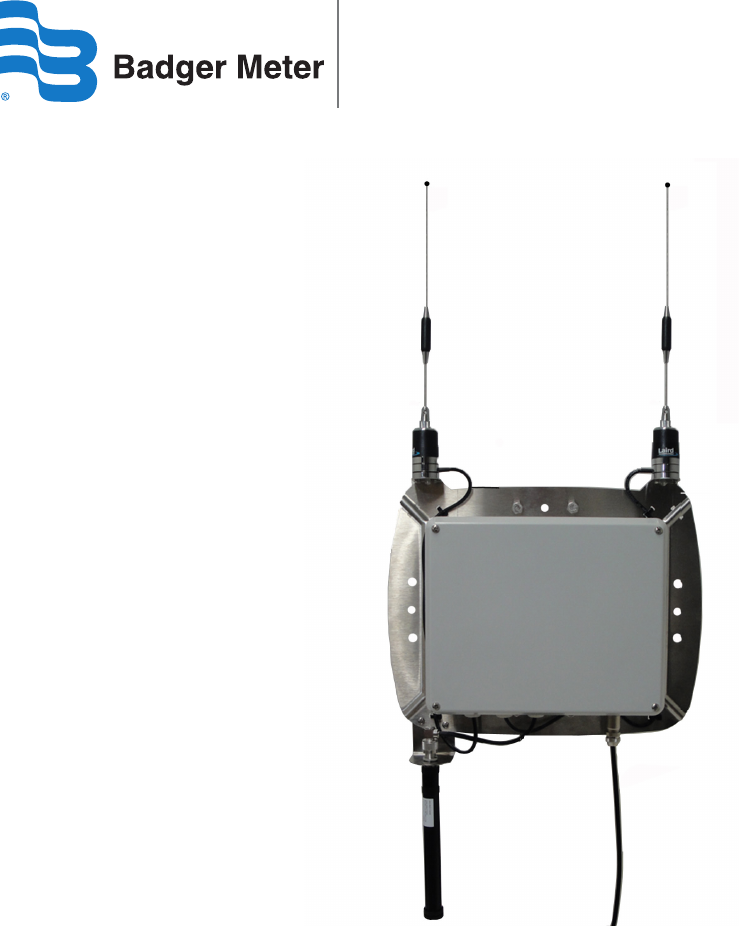
ORION® SE
Network Gateway Transceiver
Installation & Operation Manual
ORI-IOM-60-EN (June 2012)
62014-146 Rev. 3

ORION® SE Network Gateway Transceiver
Page ii June 2012

Installation & Operation Manual
Contents
OVERVIEW . . . . . . . . . . . . . . . . . . . . . . . . . . . . . . . . . . . . . . . . . . . . . . . . . . . . . . . . . . . .5
Product Description . . . . . . . . . . . . . . . . . . . . . . . . . . . . . . . . . . . . . . . . . . . . . . . . . . . .5
License Requirements . . . . . . . . . . . . . . . . . . . . . . . . . . . . . . . . . . . . . . . . . . . . . . . . . . .5
Product Unpacking and Inspection. . . . . . . . . . . . . . . . . . . . . . . . . . . . . . . . . . . . . . . . . . .5
MOUNTING THE ORION SE NETWORK GATEWAY TRANSCEIVER . . . . . . . . . . . . . . . . . . . . . . . . .6
Network Gateway Transceiver Standard Components . . . . . . . . . . . . . . . . . . . . . . . . . . . . . .6
Tools and Materials (customer-supplied) . . . . . . . . . . . . . . . . . . . . . . . . . . . . . . . . . . . . . . .7
Installation Procedure . . . . . . . . . . . . . . . . . . . . . . . . . . . . . . . . . . . . . . . . . . . . . . . . . . .7
Using the V-block Clamps. . . . . . . . . . . . . . . . . . . . . . . . . . . . . . . . . . . . . . . . . . . . . . . . .8
ELECTRICAL INSTALLATION . . . . . . . . . . . . . . . . . . . . . . . . . . . . . . . . . . . . . . . . . . . . . . . .11
AC Power . . . . . . . . . . . . . . . . . . . . . . . . . . . . . . . . . . . . . . . . . . . . . . . . . . . . . . . . . . 11
M12 Connector Assembly. . . . . . . . . . . . . . . . . . . . . . . . . . . . . . . . . . . . . . . . . . . . . . . .11
ELECTRICAL / NETWORK INSTALLATIONS . . . . . . . . . . . . . . . . . . . . . . . . . . . . . . . . . . . . . . .14
Access to Power and Use of a NEMA 4 Enclosure . . . . . . . . . . . . . . . . . . . . . . . . . . . . . . . . . 14
GPRS and Wi-Fi Recommended Installation . . . . . . . . . . . . . . . . . . . . . . . . . . . . . . . . . . . . 14
ORION SE LAN Recommended Installation . . . . . . . . . . . . . . . . . . . . . . . . . . . . . . . . . . . . . 15
ORION SE LAN Power Over Ethernet (PoE) Recommended Installation . . . . . . . . . . . . . . . . . . . 16
DC Power Source Installation . . . . . . . . . . . . . . . . . . . . . . . . . . . . . . . . . . . . . . . . . . . . . 17
RJ45 Plug Assembly (for LAN connectivity only). . . . . . . . . . . . . . . . . . . . . . . . . . . . . . . . . .18
BATTERY BACKUP REPLACEMENT . . . . . . . . . . . . . . . . . . . . . . . . . . . . . . . . . . . . . . . . . . . .20
Tools and Materials . . . . . . . . . . . . . . . . . . . . . . . . . . . . . . . . . . . . . . . . . . . . . . . . . . . .20
BATTERY DISPOSAL . . . . . . . . . . . . . . . . . . . . . . . . . . . . . . . . . . . . . . . . . . . . . . . . . . . . .21
Page iii June 2012

ORION® SE Network Gateway Transceiver
Page iv June 2012

Installation & Operation Manual
OVERVIEW
This manual contains installation and programming instructions for the ORION® SE network gateway transceiver.
Proper performance and reliability of the network gateway transceiver depends upon installation in accordance with these
instructions.
Product Description
The ORION SE network gateway transceiver is an easy-to-install, easy-to-deploy unit that collects metering data from the
ORION SE meter endpoints in the area. The network gateway transceiver uses a cellular, LAN or Wi-Fi network backhaul to
send the requested metering data back to the utility where the data can be used to better manage the utility's operation and
provide important data for improved customer service and utility operations. The ReadCenter® reading data management
software manages this data transfer process and includes myriad tools and standard reports, as well as the ability to create
any user-defined reports.
License Requirements
This device complies with Part 15 of FCC rules. Operation of this device is subject to the following conditions: (1) This device
may not cause harmful interference, and (2) this device must accept any interference received, including interference that
may cause undesired operation of the device.
In accordance with FCC regulations, “Code of Federal Regulations ” Title 47, Part 2, Subpart J, Section 1091, transmitters
pass the requirements pertaining to RF radiation exposure. However, to avoid public exposure in excess of limits for general
population (uncontrolled exposure), a 40-centimeter distance between the transmitter and the body of the user must be
maintained during testing.
No FCC license is required by a utility to operate an ORION SE meter reading system.
This device complies with Industry Canada license-exempt RSS standard(s). Operation is subject to the following two
conditions: (1) this device may not cause interference, and (2) this device must accept any interference, including interference
that may cause undesired operation of the device.
Le présent appareil est conforme aux CNR d'Industrie Canada applicables aux appareils radio exempts de licence.
L'exploitation est autorisée aux deux conditions suivantes : (1) l'appareil ne doit pas produire de brouillage, et (2) l'utilisateur
de l'appareil doit accepter tout brouillage radioélectrique subi, même si le brouillage est susceptible d'en compromettre le
fonctionnement.
IMPORTANT
Transportation: The Federal Aviation Administration prohibits operating transmitters and receivers on all commercial
aircraft. The ORION SE network gateway transceiver is considered an operating transmitter and cannot be shipped by air.
Changes: Changes or modifications to the equipment that are not expressly approved by Badger Meter could void the user’s
authority to operate the equipment. Only properly trained and authorized personnel should install and/or maintain this
equipment.
Product Unpacking and Inspection
Upon opening the shipping container, visually inspect the product and applicable accessories for any physical damage such
as scratches, loose or broken parts, or any other sign of damage that may have occurred during shipment.
NOT:NIf damage is found, request an inspection by the carrier’s agent within 48 hours of delivery and file a claim with the
carrier. A claim for equipment damage in transit is the sole responsibility of the purchaser.
Page 5 June 2012
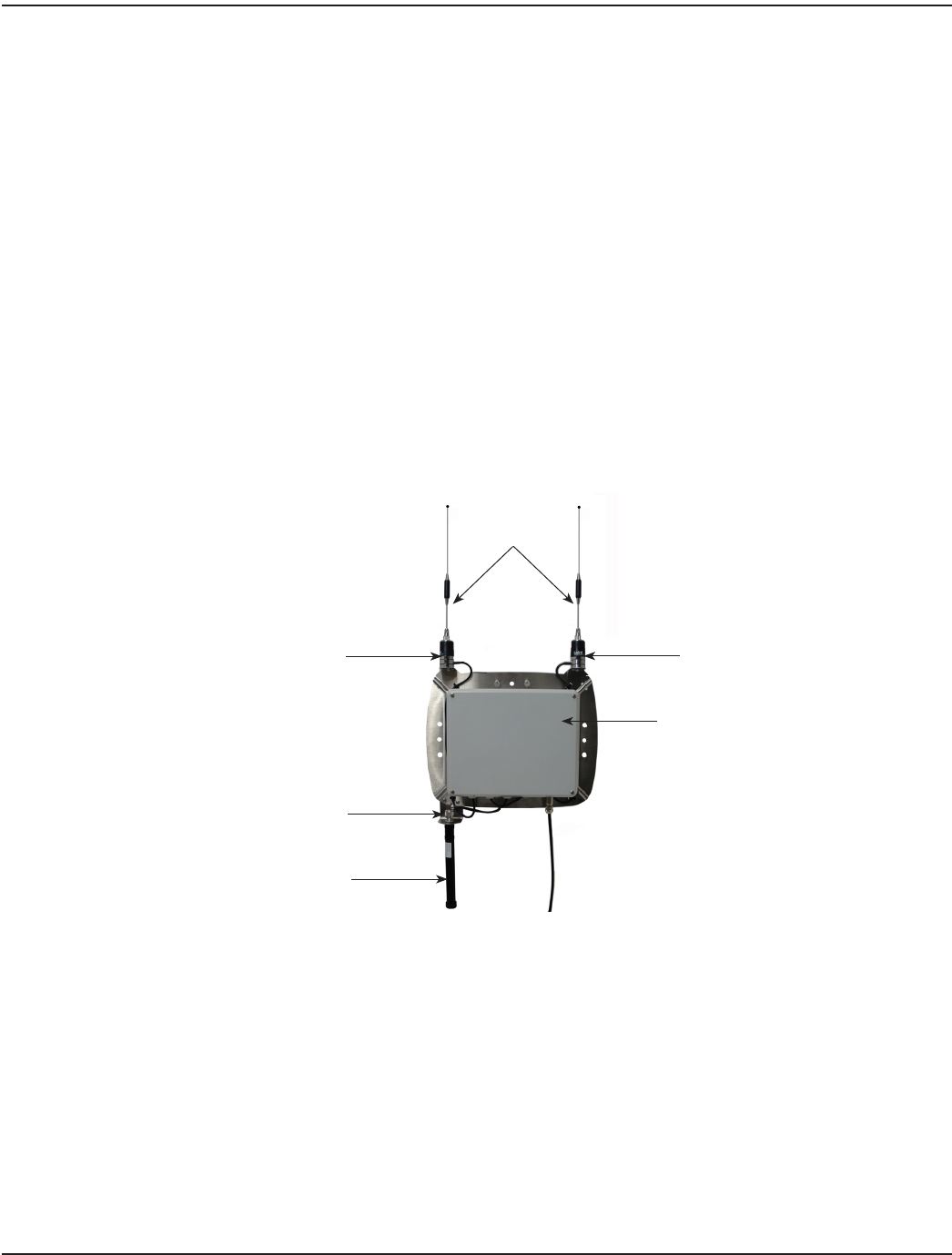
ORION® SE Network Gateway Transceiver
MOUNTING THE ORION SE NETWORK GATEWAY TRANSCEIVER
IMPORTANT
TRANSCEIVER INSTALLATION, MOUNTING AND DISPOSAL SHALL BE IN ACCORDANCE WITH ALL LOCAL, STATE AND
FEDERAL REGULATIONS. WHEN INSTALLING THE TRANSCEIVER, THE CUSTOMER IS RESPONSIBLE FOR COMPLYING WITH
LOCAL, STATE AND FEDERAL CODES AND GUIDELINES AS WELL AS APPLICABLE INDUSTRY STANDARDS, SUCH AS ANSI/
TIA/EIA 222 STRUCTURAL STANDARDS FOR STEEL ANTENNA TOWERS AND ANTENNA SUPPORTING STRUCTURES AND
THE NATIONAL ELECTRICAL CODE NEC. PROPER GROUNDING IS NECESSARY, AND IN THE CASE OF A WOODEN POLE, A
DEDICATED COPPER GROUND WIRE SHOULD BE USED FOR LIGHTNING PROTECTION.
Network Gateway Transceiver Standard Components
• Two removable whip antennas with O-rings. One GPRS and Wi-Fi backhaul antenna is included with GPRS and Wi-Fi
gateway units.
• One ORION SE network gateway transceiver with attached mounting backplate.
• V-block clamps or banding and locking equipment for attaching an ORION SE network gateway transceiver to a pole.
• 100-foot or 300-foot power cable, M12 connector, AC-to-DC power supply and power cord.
Figure 1: Transceiver Components (GPRS unit shown)
Antenna Receptacle
Transceiver Enclosure Cover
Antenna Receptacle
Backhaul Antenna
Type N Connector
Whip Antennas
GPRS or Wi-Fi Antenna
Page 6 June 2012
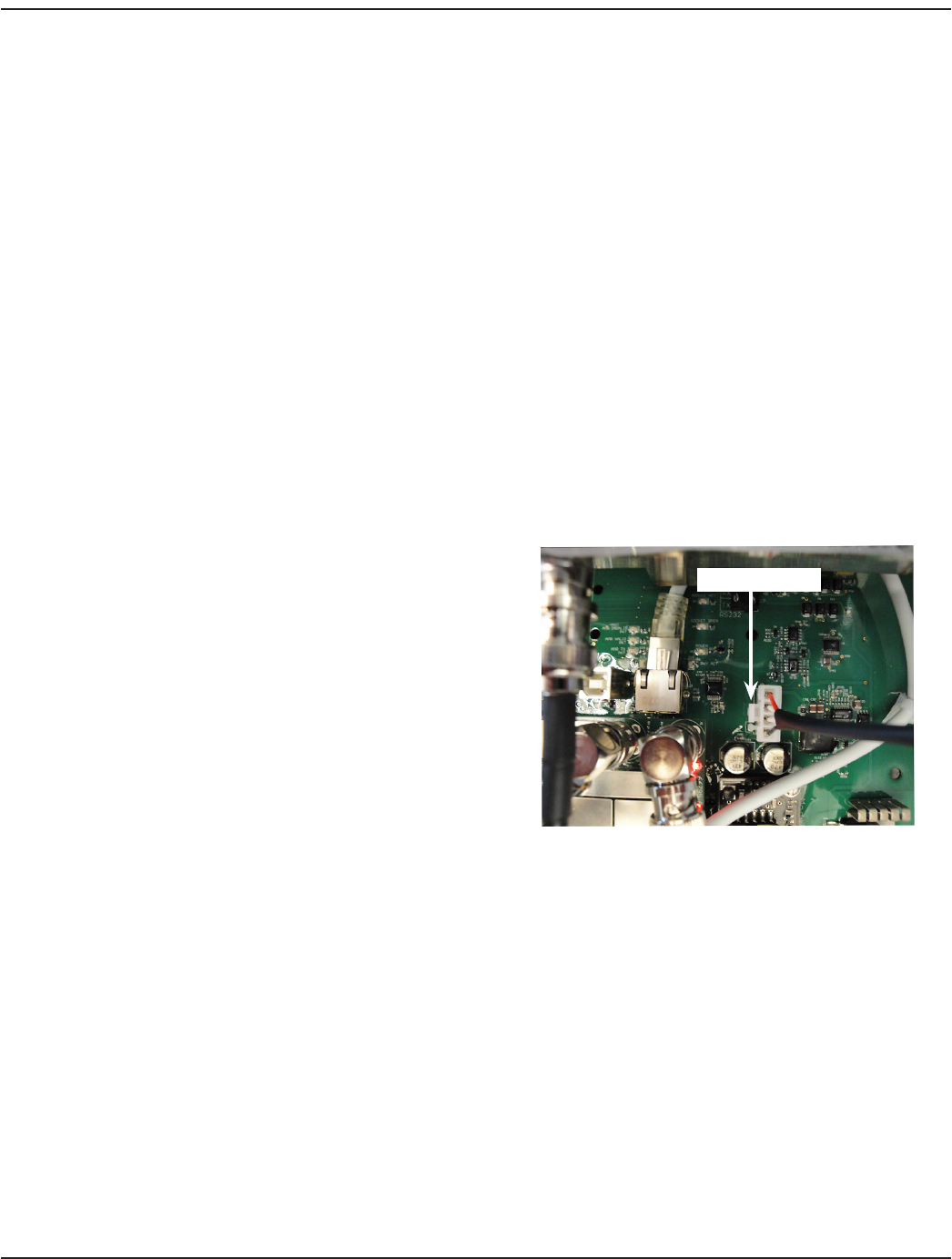
Installation & Operation Manual
Tools and Materials (customer-supplied)
• Phillips #2 screwdriver
• Precision slotted screwdriver with a 2.0 millimeter (0.079 inch) blade size
• Two 9/16-inch or adjustable wrenches for mounting V-block clamps (standard mounting)
• BAND-IT® tool (refer to page 9) and instructions, a 1/2-inch wrench and a hammer for large diameter pole
mounting
• Wrench (for 1 1/16-inch gland nut and 1 1/16-inch dome nut)
• Pliers or strap wrench (for tightening the 15/16-inch OD backhaul antenna)
Installation Procedure
NOT:NThe utility is responsible for properly positioning the ORION SE network gateway transceiver. For optimal reception
and transmission, locate the network gateway transceiver and antennas in line-of-site view of the desired endpoints.
The ORION SE network gateway transceiver should be positioned no closer than 25 feet from the nearest endpoint.
Connecting the Battery Backup
The ORION SE network gateway transceiver contains an onboard battery backup. The battery must be connected before the
network gateway transceiver is installed and powered. Follow these steps to connect the battery backup.
NOT:NRefer to "Battery Backup Replacement" on page 20 for details on replacing the battery.
1. Using a #2 slotted or Phillips screwdriver, remove the
enclosure cover by unscrewing four corner-cover
screws.
NOT:NThe battery is held in place by the enclosure
cover only. No other adhesive or locking
mechanism is used.
2. Carefully install the battery connector onto the circuit
board. Insert the connector only far enough so that the
connector latch engages. Verify that proper connector
polarity is observed.
3. Replace the enclosure cover. Tighten each of the four
cover screws to 16 inch-pounds, maximum. Be careful
not to overtighten any of the screws. Figure 2: Battery connector latch
Attaching the Whip Antennas
1. Unpack the network gateway transceiver and locate the whip antennas.
2. Verify that a rubber O-ring is in place in the O-ring gland at the bottom of both whip antennas.
3. By hand, place a whip antenna onto an antenna receptacle and then thread the antenna clockwise to tighten to the
full compression of the O-ring.
4. Repeat Step 3 for the other whip antenna.
Attaching the GPRS or Wi-Fi Antenna
1. Remove plastic cover from the Type N female connector on backhaul bracket.
2. Remove backhaul antenna from the carton.
3. Thread the Type N male connector (antenna) onto the Type N female connector on the backhaul bracket.
4. Hand tighten until nger-tight, then use pliers or a strap wrench to tighten an additional 1/16 of a turn (maximum).
Do not over-tighten or the connector may be damaged.
Connector Latch
Page 7 June 2012
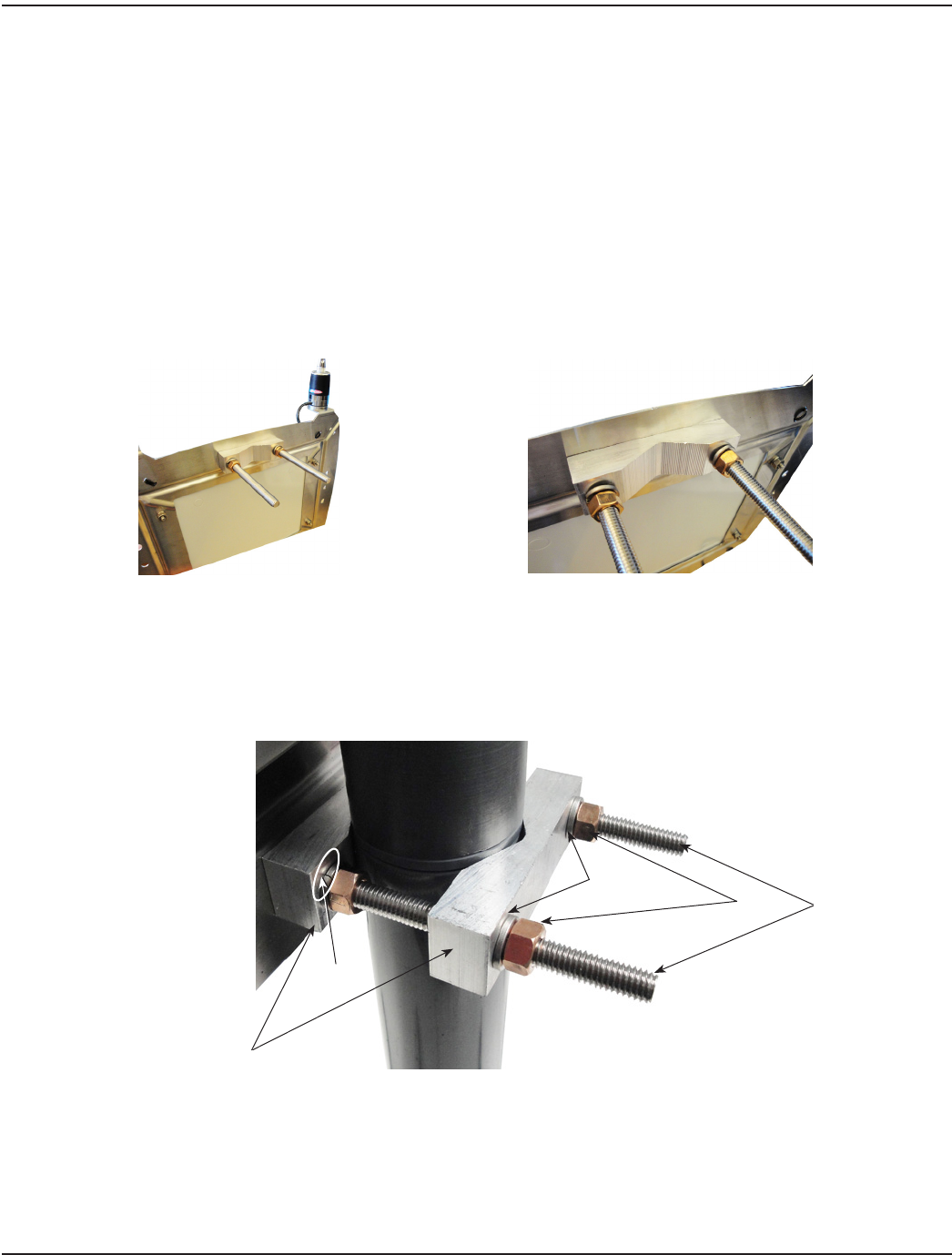
ORION® SE Network Gateway Transceiver
Using the V-block Clamps
This mounting equipment is sized to mount the network gateway transceiver on a vertical or horizontal pole with outer
diameters ranging from 1-1/4 inches to 2-1/2 inches. For mounting on poles larger than 2-1/2 inches, refer to "Banding
Mounting" on page 9.
1. Open the bag of mounting equipment.
2. Place two bolts (3/8-16 x 5 inches) through the holes in the top of the network gateway transceiver mounting
backplate (Figure 3). Use the side holes for horizontal installation.
3. Place a clamp onto the bolts, as shown below.
4. Place a lock washer and nut onto each bolt, as shown below.
NOT:NThe lock washer and nut nearest the enclosure mounting bracket may be omitted when mounting on smaller
diameter poles to provide additional clamping distance.
Figure 3: Attach Hardware
5. Tighten the two nuts with a 9/16-inch or adjustable wrench so that each lock washer is fully compressed and at.
6. Repeat Steps 2 through 5, attaching a clamp to the bottom of the network gateway transceiver mounting backplate.
Position the network gateway transceiver on the pole and place a clamp on the top bolts.
Figure 4: Transceiver Positioning and Clamps
Bolts
Clamps
Nuts
Lock
Washers
Lock
Washer
Page 8 June 2012
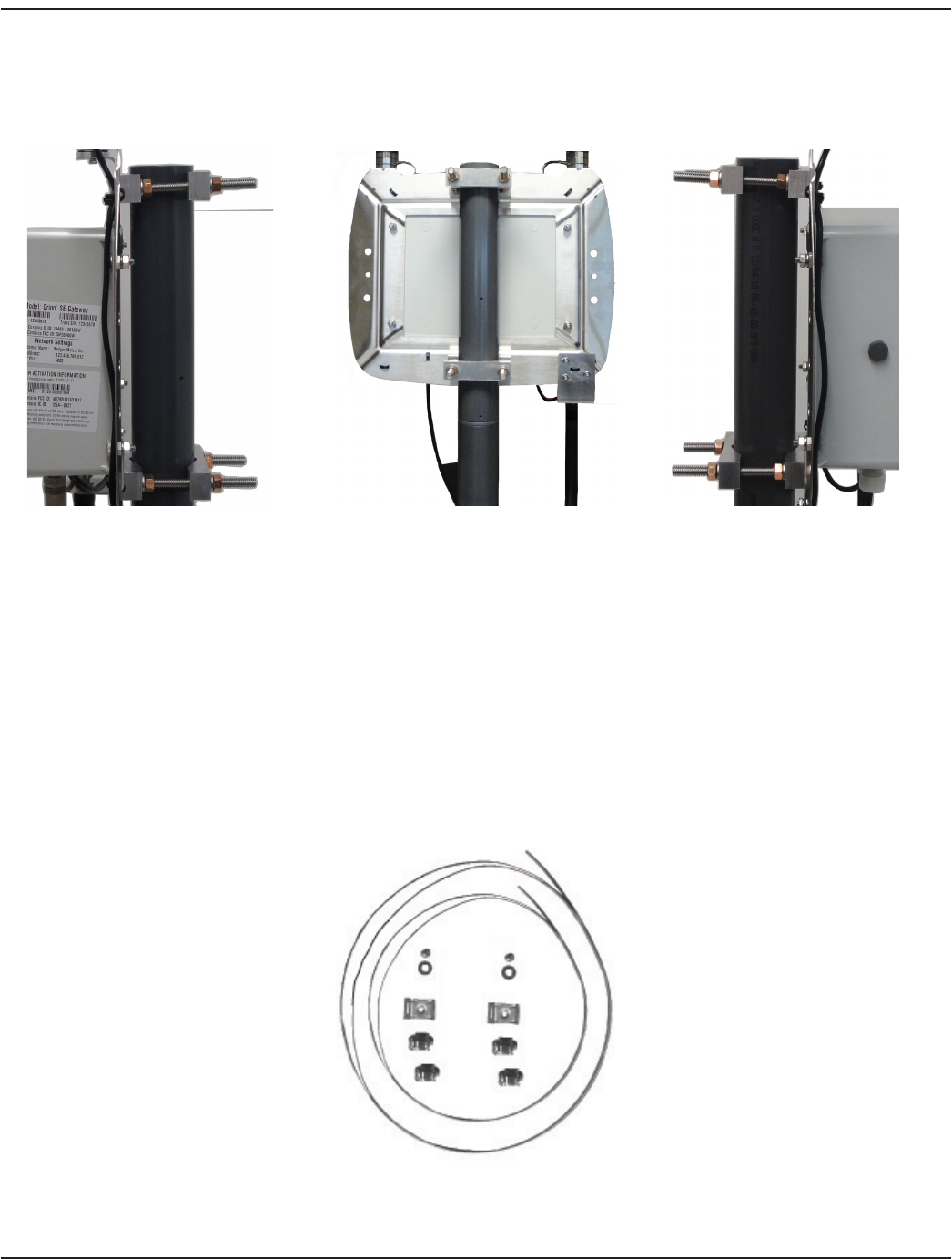
Installation & Operation Manual
7. Place a lock washer and nut on each bolt and tighten the nuts 100…150 inch-pounds to ensure the network gateway
transceiver is suciently secured to the pole.
8. Repeat Steps 7 and 8 for attaching the V-block clamp mounting bracket hardware to the bottom bolts of the network
gateway transceiver mounting backplate.
Side View Back View Side View
Figure 5: Completed Network Gateway Transceiver Mounting (GPRS unit shown)
Banding Mounting
This mounting equipment is sized to mount the network gateway transceiver on a 2-1/2…24-inch outer diameter pole.
IMPORTANT
When using the banding mounting kit for the network gateway transceiver, use BAND-IT Idex installation practices. Refer to
www.band-it-idex.com/en/Literature/Tool_Instructions/P05886.pdf for more information. This is especially applicable when
mounting on a non-tapered vertical pole, as the banding could loosen over time resulting in the unit sliding down the pole.
To mount the ORION SE network gateway transceiver on a pole, gather the banding and locking equipment.
Figure 6: Banding and Locking Equipment
Page 9 June 2012
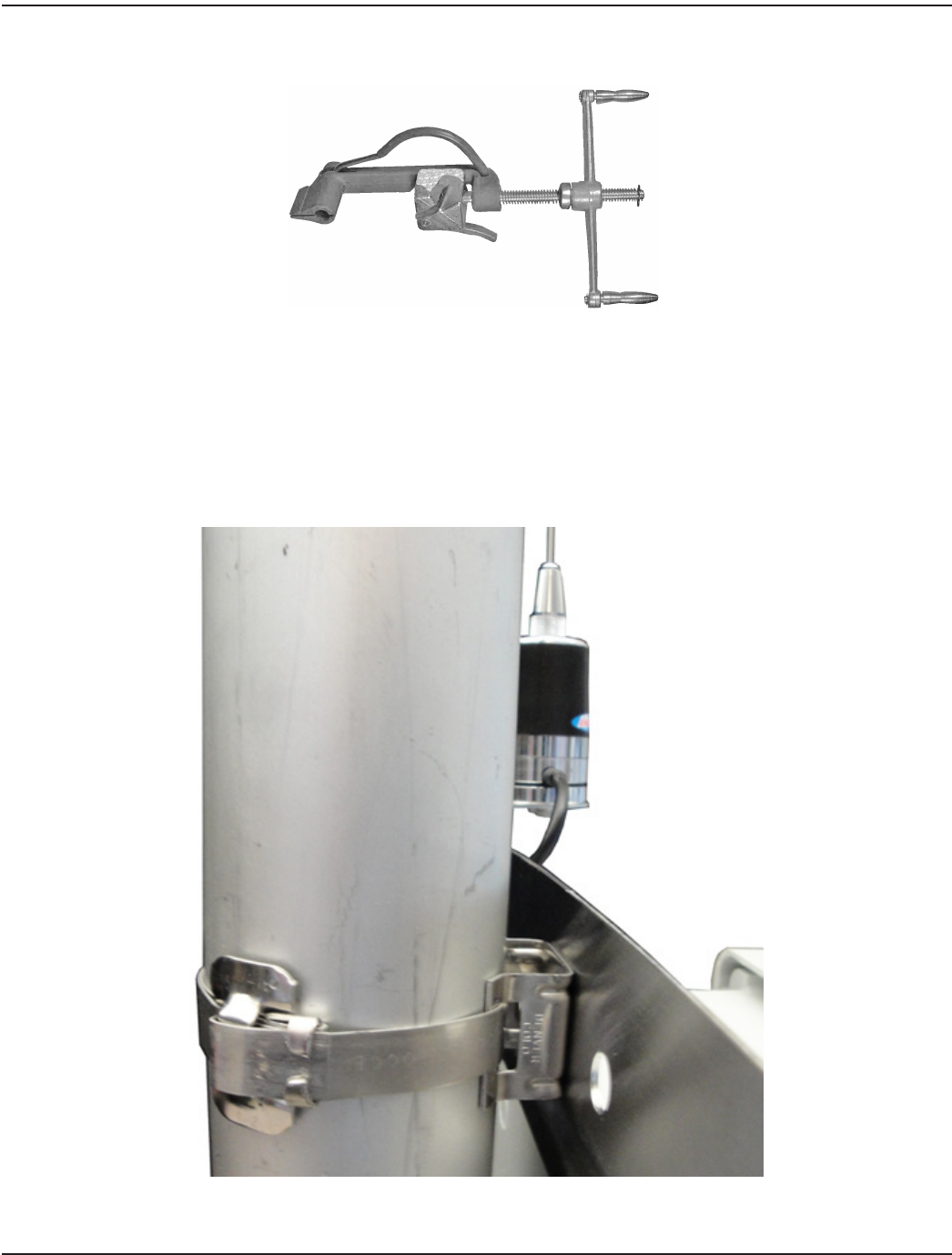
ORION® SE Network Gateway Transceiver
NOT:NInstallation of banding mounting kit requires use of the BAND-IT tool shown below (66042-006) or equivalent
BAND-IT tool as recommended by BAND-IT.
Figure 7: BAND-IT Tool
1. Locate the BAND-IT tool and supplied installation instructions.
2. Follow the BAND-IT-supplied installation instructions enclosed with the BAND-IT tool for attaching the network
gateway transceiver to a pole.
3. Using a 1/2-inch wrench, apply the recommended torque for the 5/16-24 screw that attaches the network gateway
transceiver bracket to the BAND-IT banding. The recommended torque is 144…168 inch-pounds
(12…14 foot-pounds).
Figure 8: Network Gateway Transceiver Shown with BAND-IT Mounting Hardware
Page 10 June 2012
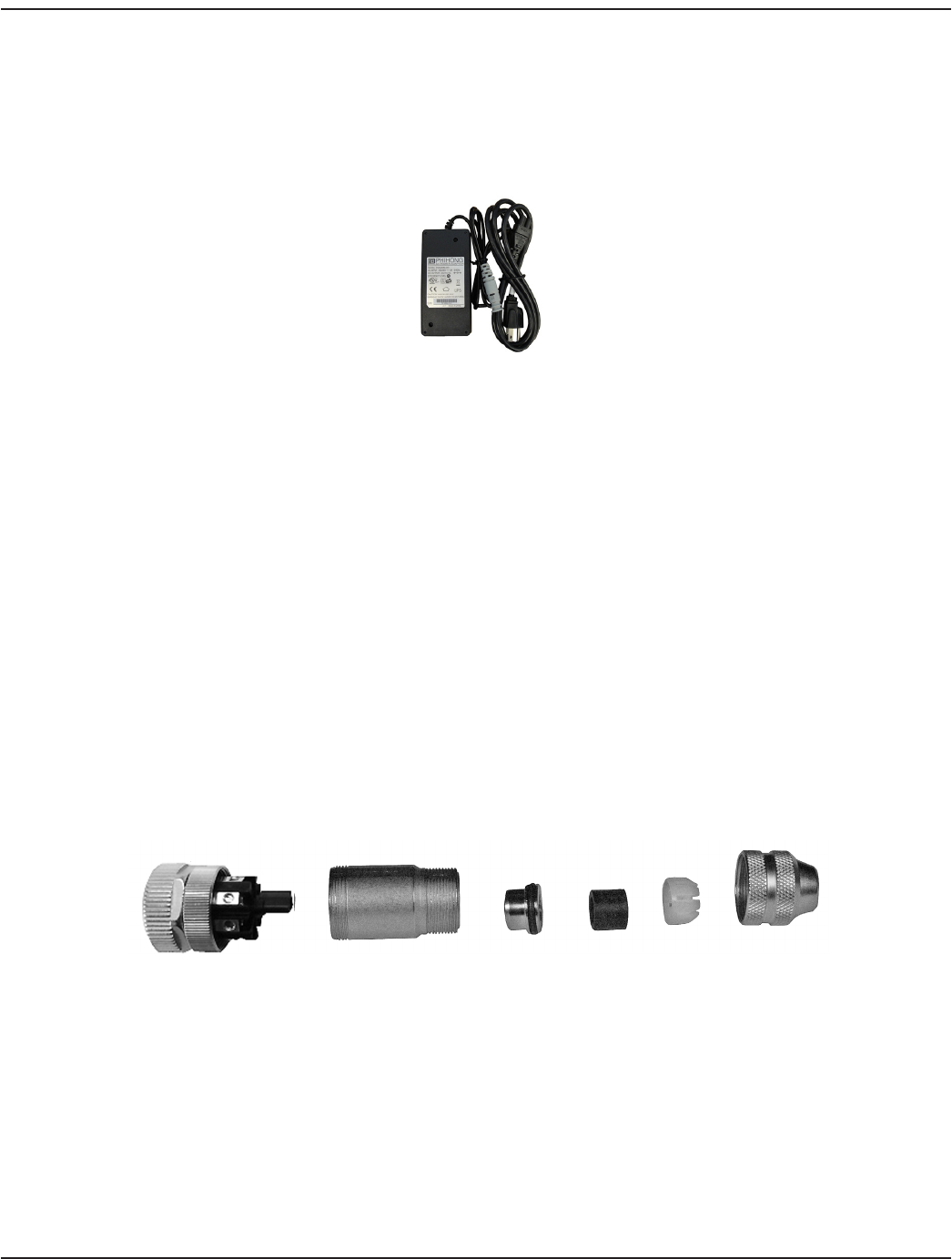
Installation & Operation Manual
ELECTRICAL INSTALLATION
AC Power
Badger Meter provides an AC-to-DC power supply that plugs into a standard three-prong 120V AC outlet. If powering the
network gateway transceiver directly via DC power, please refer to the DC power information on page 17.
Figure 9: 120V AC Power Supply with Power Cord
M12 Connector Assembly
NOT:NUse only approved Badger Meter power cable, 100 foot (66233-015) or 300 foot (66233-017), for this assembly.
Tools and Materials
• M12 plug, 8-conductor connector (66525-002)
• Badger Meter power cable, 100 feet or 300 feet with 308 in-line connector end
• 308 in-line connector anti-tamper collar
• Coax stripper (customer supplied)
• Wire stripper for 22 AWG wires (customer supplied)
• Precision slotted screwdriver with blade size of 2.0 millimeter (0.079 inch) (customer supplied)
M12 Plug Connector Part Names
Figure 10: M12 Plug Connector Parts
1. Push the connector parts onto the power cable in the following order: pressure nut, clamping cage, cable seal, sleeve
with O-ring and nally, the coupling sleeve.
Female Insert Coupling Sleeve Sleeve
w/O-ring Cable
Seal
Clamping
Cage
Pressure
Nut
Page 11 June 2012
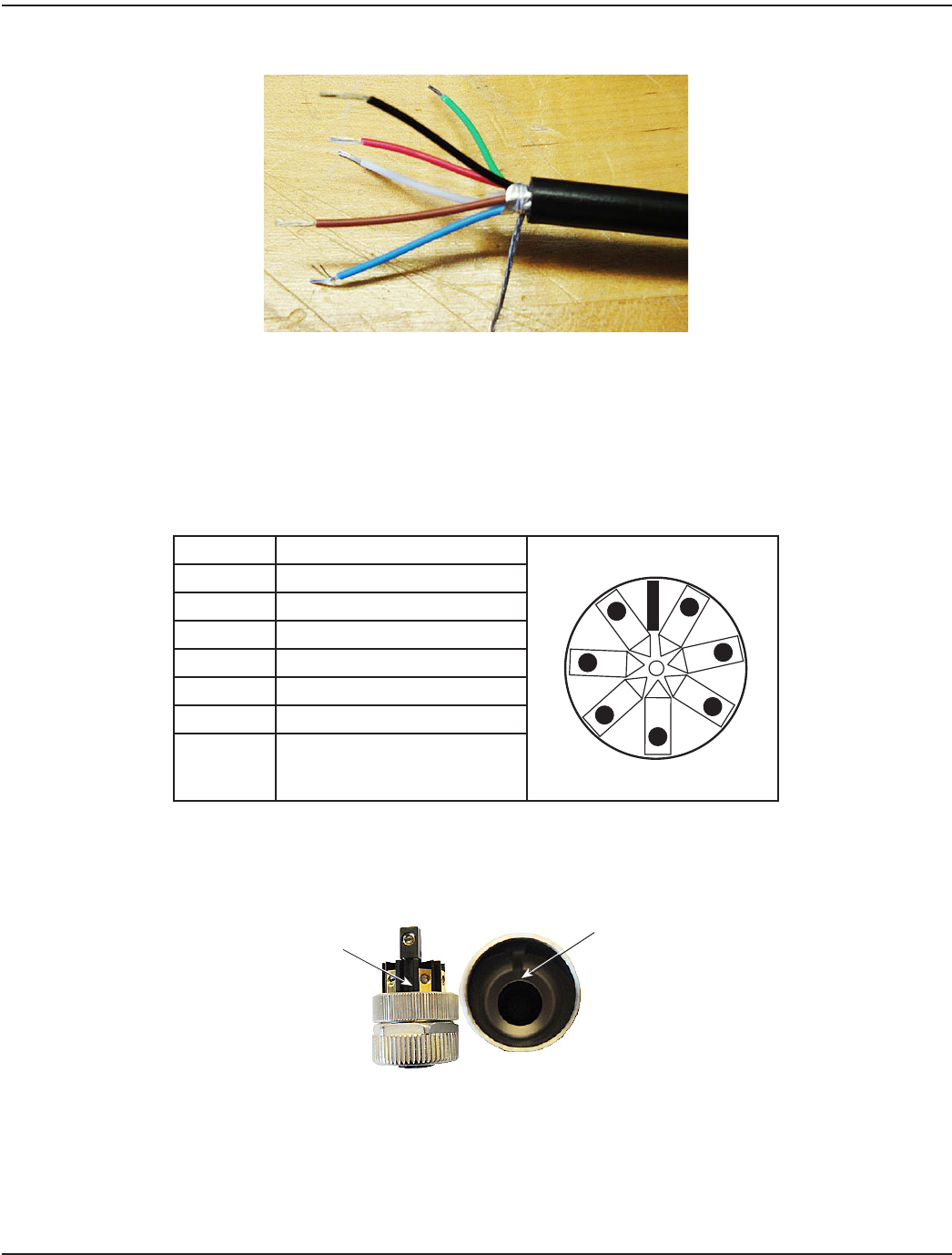
ORION® SE Network Gateway Transceiver
2. Strip the cable outer jacket to a maximum length of 1.1 inches.
Figure 11: Stripped Cable Wires
3. Shorten the foil shield ush with the outer jacket.
4. Strip the ends of the six (6) colored wires to a length of 1/8 inch. Twist the conductors on each wire.
5. Shorten the drain/bare wire (no insulation) to 11/16 inch.
6. Loosen the screws on the female insert and attach the wires to the female insert using the chart below. Retighten the
screws after each wire has been connected.
Wire Female insert connector
Slot
Red
1
2
3
4
5
7
8
Brown
Black
White
Green
8 (center) is for the shield-drain
M12 Connector Wire Contact View
Blue
White 4
Drain 8 (Center)
Black 3
Blue 7
Red 1
Green 5
Brown 2
7. Assemble the female insert to the coupling sleeve by aligning the female insert tab slot with the notch in the
coupling sleeve.
Figure 12: Slot Alignment
Female Insert
Tab Slot
Coupling Sleeve Insert
Notch
Page 12 June 2012
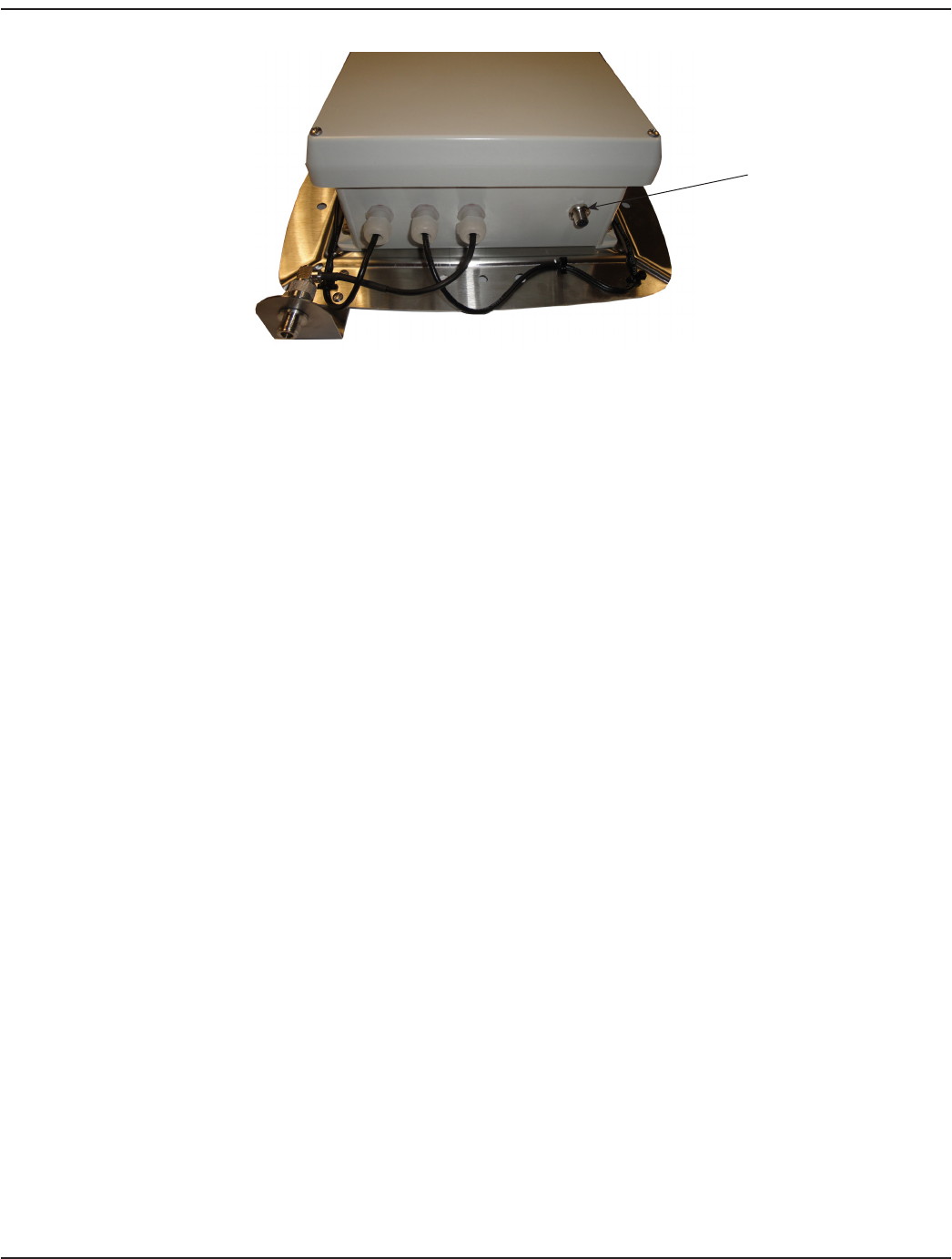
Installation & Operation Manual
Figure 13: Bottom of Network Gateway Transceiver (GPRS unit shown)
8. Remove the M12 cap from the M12 receptacle on the bottom of the network gateway transceiver and discard the
cap.
9. Connect the M12 plug connector assembly to the M12 receptacle and tighten the locking ring in a clockwise
direction until nger tight.
10. Connect the 308 connector on the other end of the power cable to the 308 connector of the AC-to-DC power supply
and snap the anti-tamper collar over the connection.
11. Connect the power cord to the power supply and then plug the three-prong male end of the power cord into a
120V AC power source.
M12 Cap Removed
Page 13 June 2012
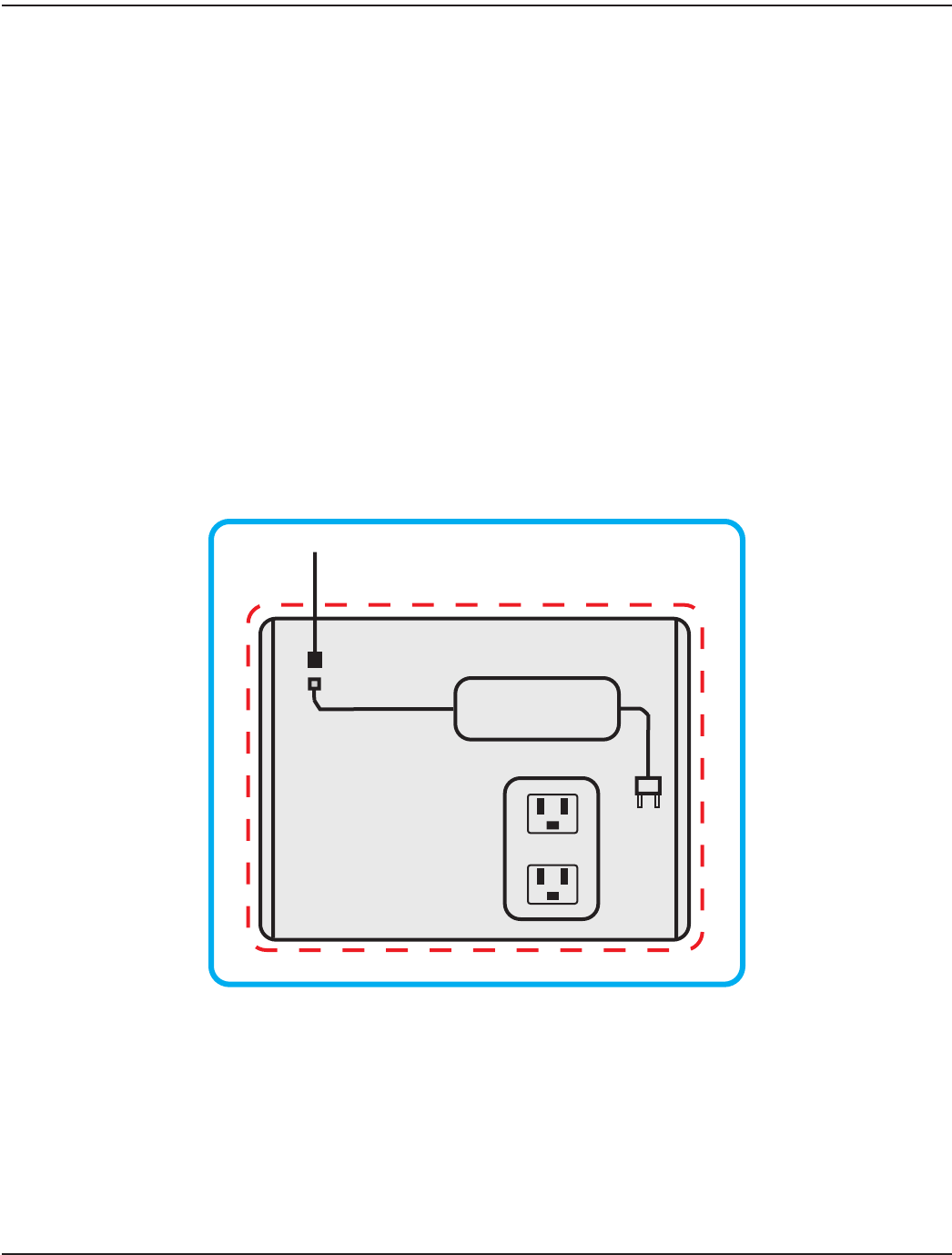
ORION® SE Network Gateway Transceiver
ELECTRICAL / NETWORK INSTALLATIONS
Access to Power and Use of a NEMA 4 Enclosure
• The ORION SE network gateway transceiver requires access to power and can use either a 120V AC grounded outlet
for use with the AC-to-DC power supply and power cord (66528-002) or a DC power source to be used with the DC
power source cable with 308 in-line connector (Figure 14).
• Use of NEMA 4 enclosure, or equivalent.
• AC-to-DC power supply used outdoors or in a non-environmentally controlled indoor location requires a
customer-supplied NEMA 4 enclosure, or equivalent, installed in accordance with appropriate electrical codes,
building codes, industry codes, regulations and standards.
• Consult the appropriate electrical, building and industry codes, regulations and standards for accepted
installation practices for use of the AC-to-DC power supply and outlet in environmentally controlled indoor
locations.
• Outlet and enclosure (if required) should be mounted for easy accessibility by authorized utility personnel at the
installation site.
GPRS and Wi-Fi Recommended Installation
AC to DC Power Supply with
308 In-line Connector End and
Power Cord (supplied)
120VAC
Grounded Outlet
(customer
supplied)
Power Supply Cable with
308 In-line Connector
ORION SE Power Cable with
308 In-line Connector
(supplied)
Figure 14: GPRS / Wi-Fi Connections (*Shown with NEMA 4 enclosure.)
*An enclosure may be recommended but is not included.
If NEMA 4 enclosure or equivalent is required, the minimum enclosure size is 12 inch x 10 inch x 6 inch (H x W x D).
Page 14 June 2012
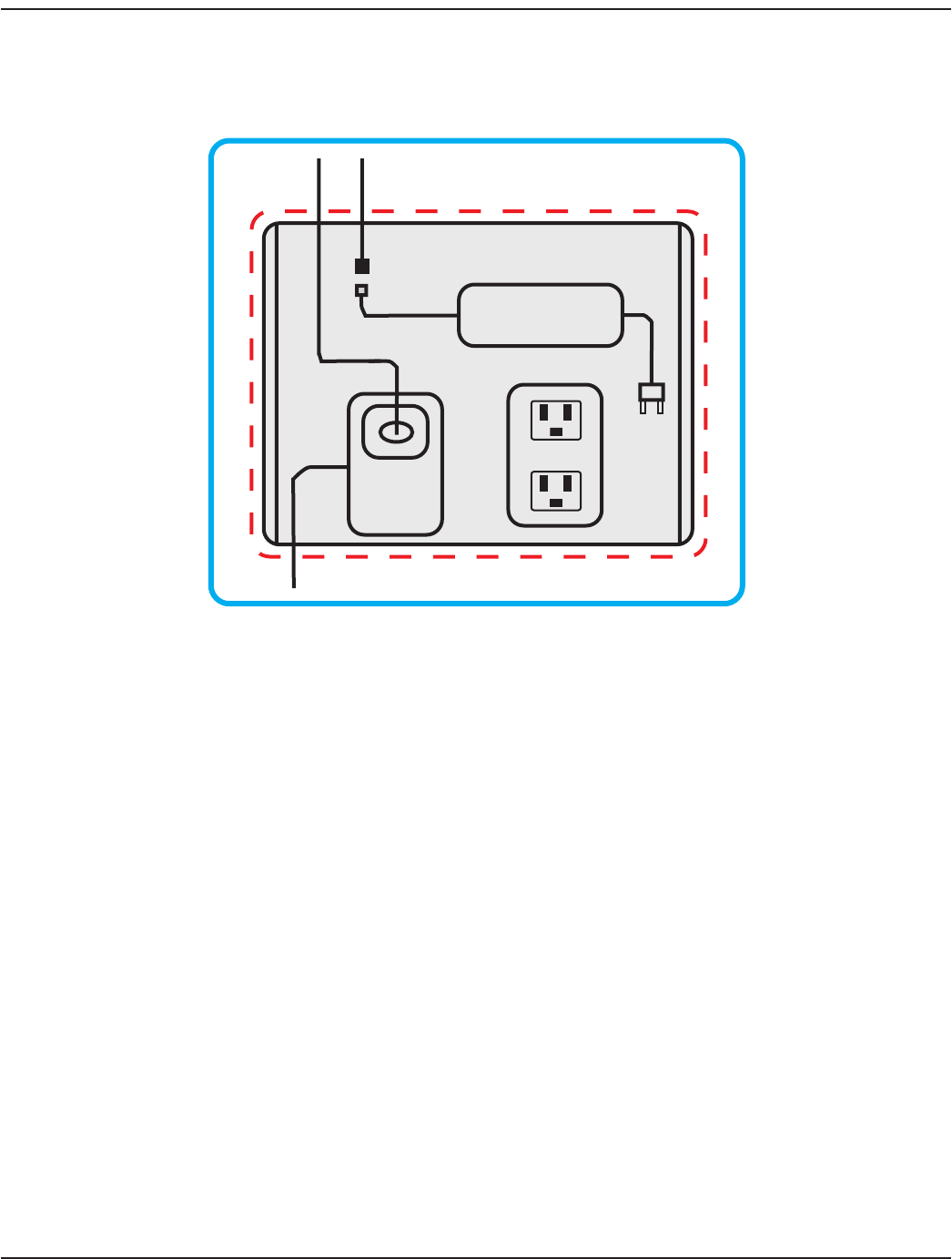
Installation & Operation Manual
ORION SE LAN Recommended Installation
NOT:NConsult the manufacturer's installation and usage recommendations as well as appropriate codes, regulations and
standards for the LAN RJ45 Ethernet connection.
AC to DC Power Supply with 308
In-line Connector End and Power Cord
(supplied)
120VAC
Grounded Outlet
(customer
supplied)
To Utility
Network
Outdoor-rated
CAT5e Ethernet
Cable (customer
supplied)
LAN RJ45 Ethernet
Connection
(customer supplied)
Power Supply Cable with
308 In-line Connector
ORION SE Power Cable with
308 In-line Connector
(supplied)
Figure 15: LAN Connections with Separate AC Power (* Shown with NEMA 4 enclosure.)
*An enclosure may be recommended but is not included.
Page 15 June 2012
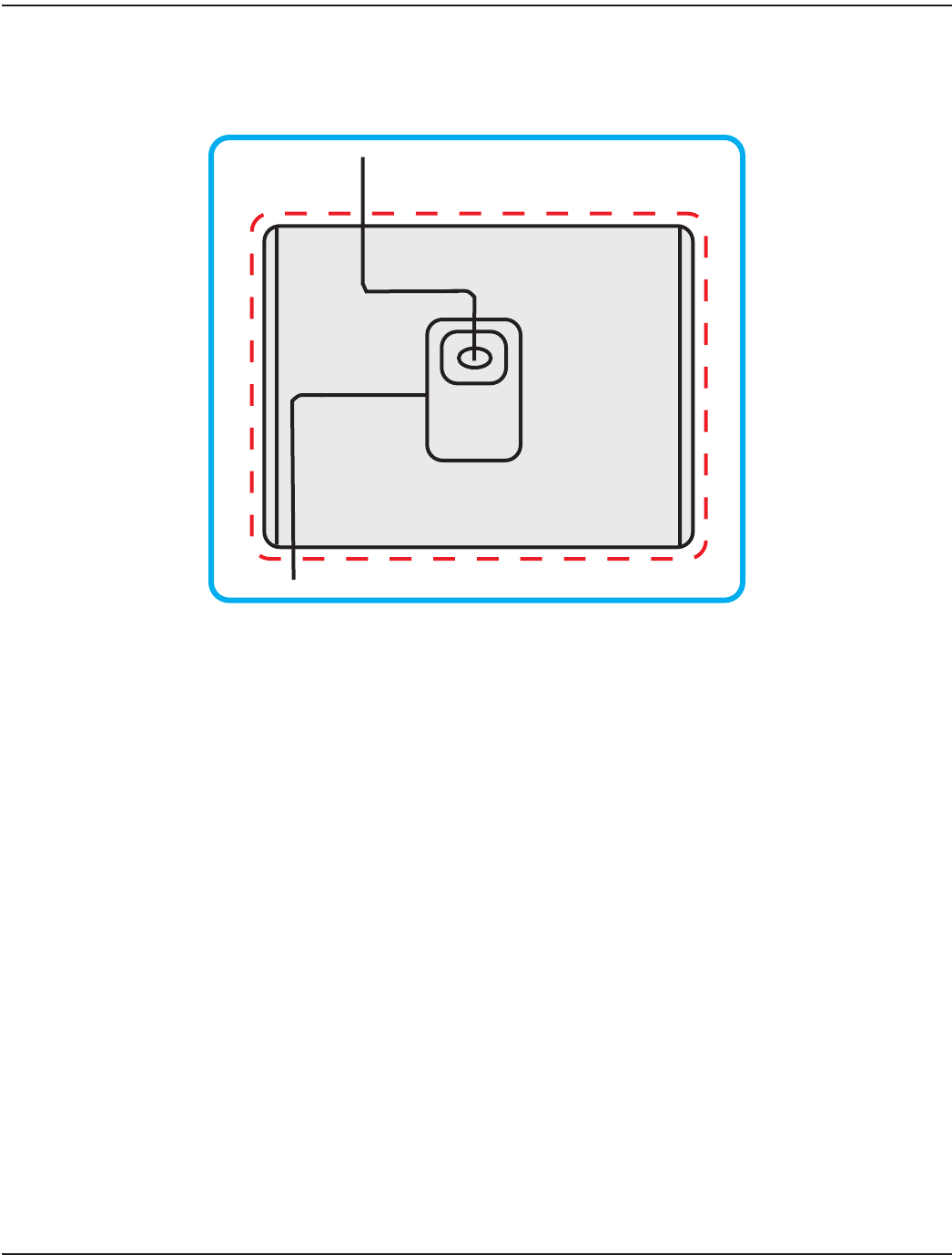
ORION® SE Network Gateway Transceiver
ORION SE LAN Power Over Ethernet (PoE) Recommended Installation
NOT:NConsult the manufacturer's installation and usage recommendations as well as appropriate codes, regulations and/or
standards for the LAN RJ45 Ethernet connection.
To Utility
Network
CAT5e Outdoor-rated
Ethernet Cable
(customer supplied)
PoE LAN RJ45
Ethernet
Connection
(customer
supplied)
Figure 16: PoE LAN Connections (* Shown with NEMA 4 enclosure.)
*An enclosure may be recommended but is not included.
Page 16 June 2012
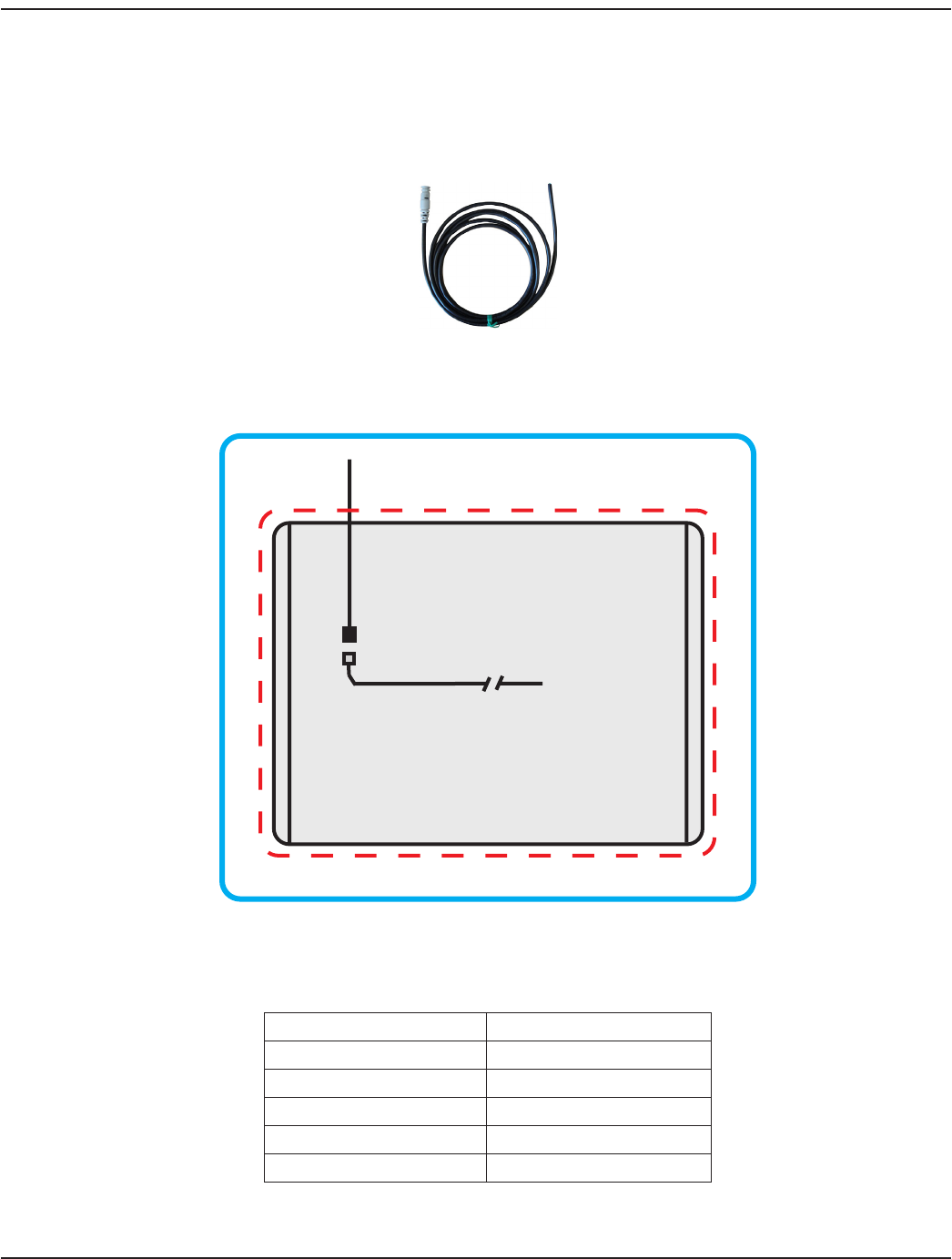
Installation & Operation Manual
DC Power Source Installation
The ORION SE network gateway transceiver may be ordered with a 10-foot DC power source cable for direct connection with
a customer-supplied DC power source (24V DC @ 1A minimum). When connecting an AC-to-DC power supply, the electrical
requirement for the network gateway transceiver is 1 amp (minimum) at 24V DC. When connecting directly to batteries, as in a
solar assembly (not supplied), the minimum electrical requirement is 0.4 amp at 24V DC.
Figure 17: 10' DC Power Cable
NOT:NConsult the appropriate electrical, building and industry codes, regulations and standards for accepted installation
practices when attaching the cable to a DC power source.
DC Power Source
(customer supplied)
10-foot DC Power Source Cable
with 308 In-line Connector End
(supplied)
ORION SE Power Cable with
308 In-line Connector
(supplied)
Figure 18: DC Power Source Installation (* Shown with NEMA 4 enclosure.)
*The enclosure may be recommended but is not included.
External DC power source connections:
Wire Color for 66233-020 External DC Power Source
Drain (no insulation) Negative (–)
Black Negative (–)
Brown Negative (–)
Red Positive (+)
Light Blue Positive (+)
Page 17 June 2012

ORION® SE Network Gateway Transceiver
RJ45 Plug Assembly (for LAN connectivity only)
Required Supplies:
• RJ45 Plug Assembly (66527-001)
• Ethernet cable cordset using outdoor-rated Cat.5e cable and RJ45 jack (customer supplied)
• Wrenches – 1-1/16 inch (customer supplied)
Figure 19: RJ45 Plug Components
1. Feed the cordset cable through the dome nut end of the cable gland.
2. Push down the RJ45 plug latch and place it inside one half of the insulator insert. Refer to Figure 20.
RJ45 PLUG
LATCH
HALF INSULATOR
INSERT
HALF INSULATOR
INSERT
RJ STOP®
PATENT
AUDIBLE
LOCKING
Figure 20: Insulator Assembly
3. Attach the other half of the insulator insert as shown. An audible click will sound when the connection has been
made.
Cable Gland
Nut
Dome Nut
Metallic Housing Insulator Insert Halves Cable Gland
Page 18 June 2012
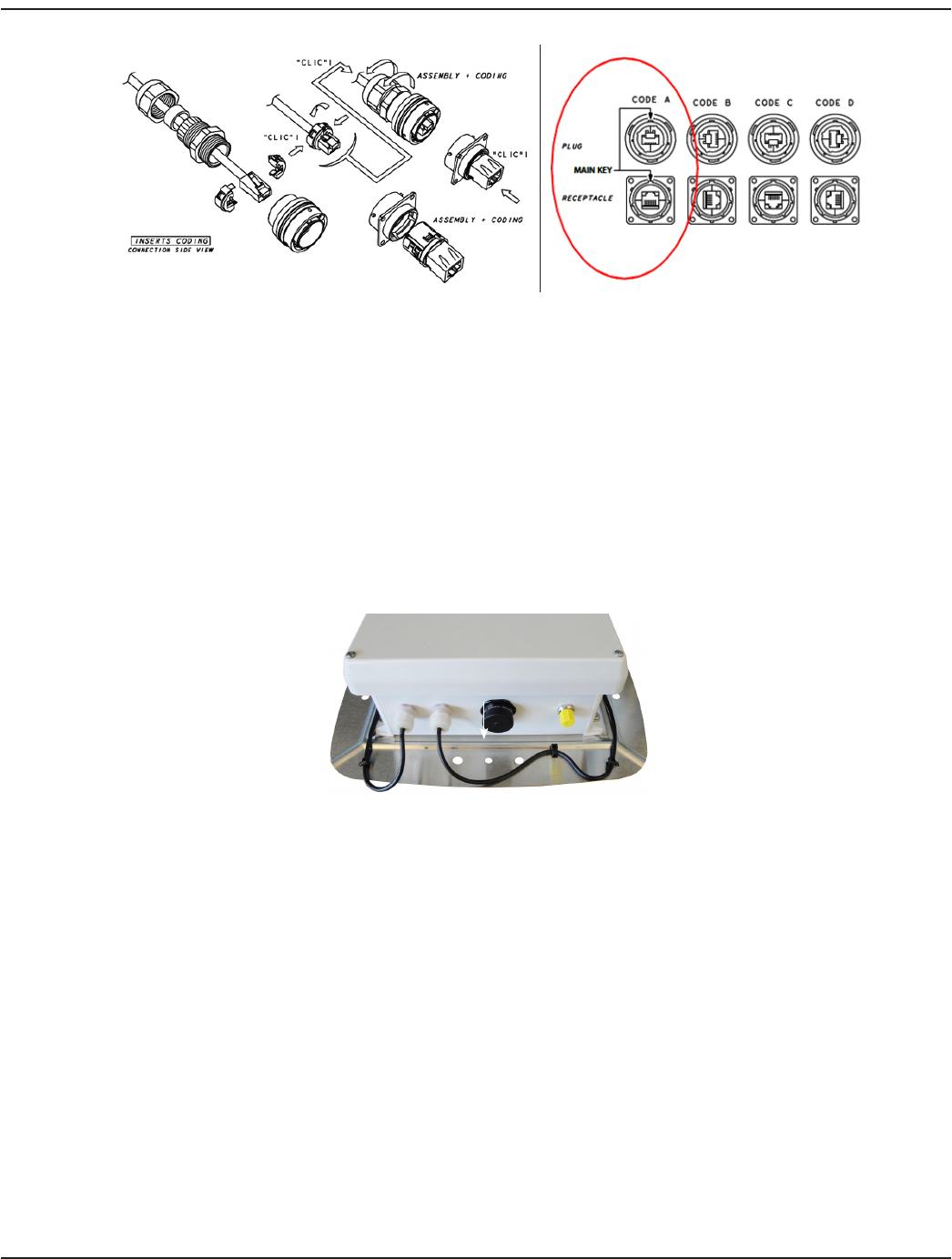
Installation & Operation Manual
Figure 21: RJ45 Plug Assembly with Code A Orientation
4. Insert the insulator assembly into the metallic housing using the Code A orientation as shown in Figure 21. An audible
click will conrm complete connection.
NOT:NCode A orientation must be used or the plug will not fit into the receptacle. Assembled RJ45 plugs cannot be
disassembled without a special tool (67163-001) and must be replaced.
5. Screw the cable gland into the metallic housing and tighten the cable gland nut to 30…45 inch-pounds using
wrenches.
6. Tighten the dome nut to 20 inch-pounds using a wrench. The dome nut seal must be in rm contact with the
outdoor-rated Cat.5e Ethernet cable.
7. Remove the bayonet lock (Figure 22) cap from the RJ45 receptacle on the ORION SE network gateway transceiver
enclosure by turning the cap 1/4 turn, counter-clockwise.
Figure 22: RJ45 Receptacle Bayonet Lock Cap (LAN with power shown)
8. Connect the RJ45 plug assembly to the RJ45 receptacle and secure by turning the metal housing 1/4 turn, clockwise.
For additional information, refer to http://www.rjfield.com/ethernet_connectors_rjf_en.htm.
Bayonet Lock Cap
Page 19 June 2012
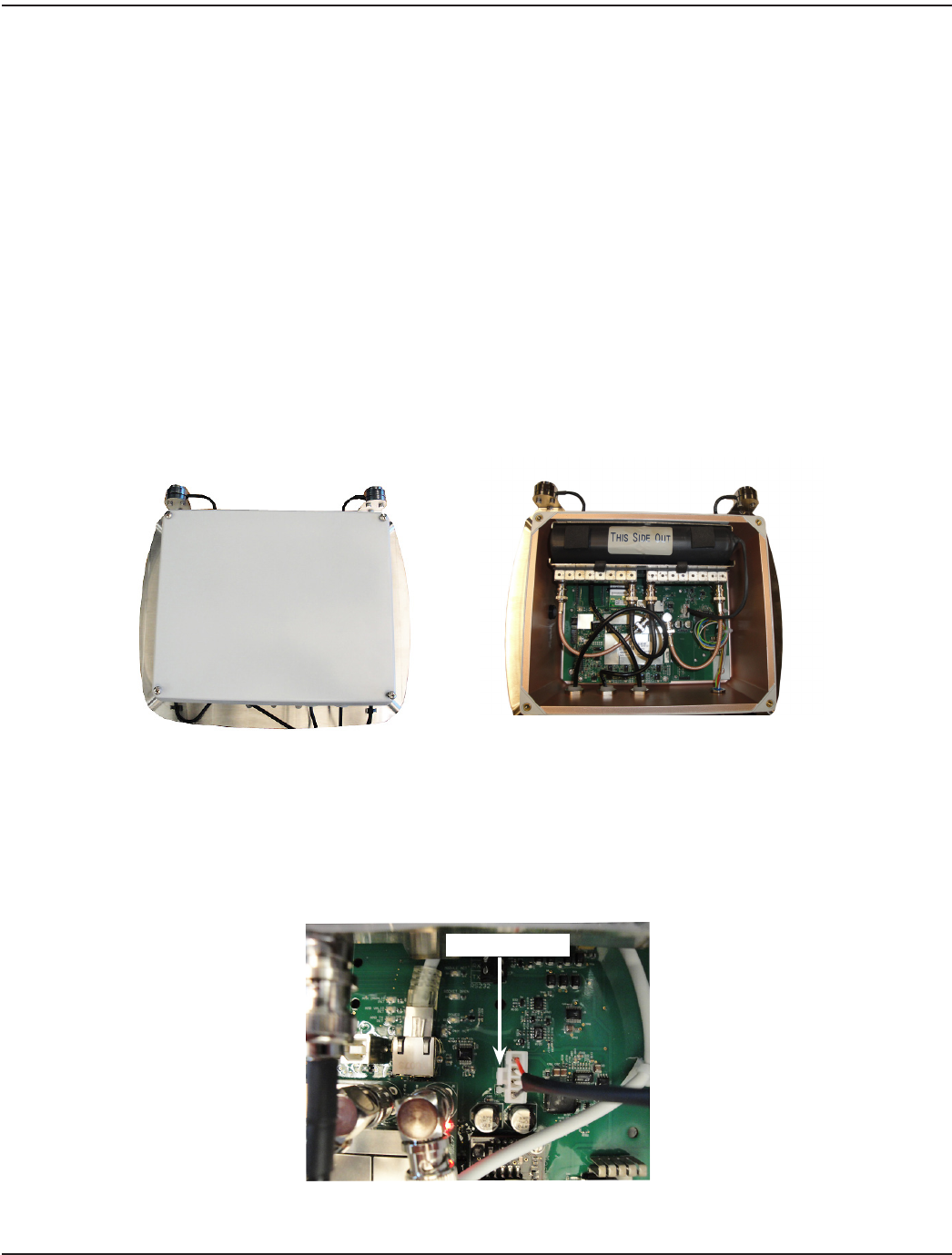
ORION® SE Network Gateway Transceiver
BATTERY BACKUP REPLACEMENT
In the event a battery replacement is required, please complete the installation steps as detailed below in the order presented.
IMPORTANT
Working with electronics requires the use of proper electrostatic discharge (ESD) protection. Grounded wrist straps are
recommended when working inside the enclosure.
NOT:NIt is not necessary to remove AC power from the network gateway transceiver before removing the cover and
replacing the battery.
Tools and Materials
• Rechargeable battery pack kit with enclosure cover (67018-001)
• #2 slotted or Phillips screwdriver
1. Using a #2 slotted or Phillips screwdriver, remove the enclosure cover by unscrewing four corner-cover screws
(Figure 23). The cover will not be used again and may be discarded.
Cover On
Figure 23: Enclosure Cover Removal (GPRS unit shown)
2. Squeeze the connector latch (Figure 24) on the battery connector on the circuit board and carefully pull on the
connector to remove it from the circuit board pin contacts. Do NOT pull on the connector wires. If the connector is
stuck, it may need to be gently rocked back and forth while pulling.
Figure 24: Battery Connector
Cover Off
Connector Latch
Page 20 June 2012

Installation & Operation Manual
NOT:NThe battery is held in place by the enclosure cover only. No other adhesive or locking mechanism is used.
3. Remove the battery from the unit (Figure 25) and safely discard the battery (see "Battery Disposal" on page 21).
Figure 25: Battery Removal
4. Place the new battery into the enclosure with the battery label “This Side Out” visible and upright, as shown above.
5. Carefully install the battery connector onto the circuit board. Insert the connector only far enough so that the
connector latch engages. Verify that proper connector polarity is observed (see "Figure 24: Battery Connector" on
page 20).
6. Install the new enclosure cover provided with the battery kit. Tighten each of the four cover screws to
16 inch-pounds, maximum, being careful to not overtighten any of the screws.
BATTERY DISPOSAL
The battery contains lead and should be handled and disposed of in accordance with local, state and federal regulations.
Refer to Badger Meter Battery Handling Safety Guide MRT-SG-02 for more information.
FAILURE TO PROPERLY DISPOSE OF A LEAD ACID BATTERY MAY RESULT IN BODILY HARM AND/OR PROPERTY DAMAGE FROM
ACID BURNS.
Page 21 June 2012

ORION® SE Network Gateway Transceiver
Intentional Blank Page
Page 22 June 2012

Installation & Operation Manual
Intentional Blank Page
Page 23 June 2012

www.badgermeter.com
ORION and ReadCenter are registered trademarks of Badger Meter, Inc. Other trademarks appearing in this document are the property of their respective entities.
Due to continuous research, product improvements and enhancements, Badger Meter reserves the right to change product or system specications without notice, except to the extent an outstanding
contractual obligation exists. © 2012 Badger Meter, Inc. All rights reserved.
The Americas | Badger Meter | 4545 West Brown Deer Rd | PO Box 245036 | Milwaukee, WI 53224-9536 | 800-876-3837 | 414-355-0400
Europe, Middle East and Africa | Badger Meter Europa GmbH | Nurtinger Str 76 | 72639 Neuffen | Germany | +49-7025-9208-0
Slovakia | Badger Meter Slovakia s.r.o. | Racianska 109/B | 831 02 Bratislava, Slovakia | +421-2-44 63 83 01
United Kingdom | Badger Meter Europa GmbH | Suite 1, Trident Business Village | Kilverstone Estate | Thetford, Norfolk IP24 2RL UK | +44-0-1842-855749
Asia Pacific | Badger Meter | Singapore Representative Office | 80 Marine Parade Rd | 21-04 Parkway Parade | Singapore 449269 | +65-63464836
China | Badger Meter | Rm 501, N° 11 Longyue Apartment | N° 180 Longjin Rd, Jiuting Songjiang District | Shanghai, China | 201615 | +86-21-5763 5412